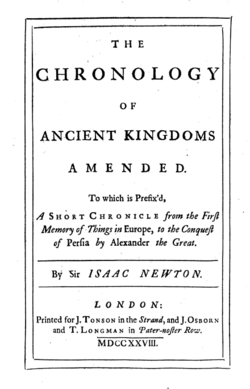History:The Chronology of Ancient Kingdoms Amended
 Title page, first edition | |
| Author | Isaac Newton |
|---|---|
| Country | England |
| Language | English |
| Subject | Chronology |
| Genre | Non-fiction |
| Publisher | J. Tonson, J. Osborn, & T. Longman |
Publication date | 1728 |
| Media type | |
| OCLC | 3834370 |
The Chronology of Ancient Kingdoms Amended is an approximately 87,000-word composition written by Sir Isaac Newton, first published posthumously in 1728 in limited supply.[1] Since then it had been republished in mass paperback format. The work represents one of Newton's forays into the topic of chronology, detailing the rise and history of various ancient kingdoms throughout antiquity.
The treatise is composed of eight primary sections. First is an introductory letter to Caroline of Ansbach, the Queen of England by Newton's estate manager John Conduitt, followed by a short advertisement. After this is found a section entitled "A Short Chronicle" which serves as a brief historical list of events listed in chronological order, beginning with the earliest listed date of 1125 BC and the most recent listed at 331 BC. The majority of the treatise, however, is in the form of six chapters that explore the history of specific civilizations. These chapters are titled:
- Chap. I. Of the Chronology of the First Ages of the Greeks.
- Chap. II. Of the Empire of Egypt.
- Chap. III. Of the Assyrian Empire.
- Chap. IV. Of the two Contemporary Empires of the Babylonians and Medes.
- Chap. V. A Description of the Temple of Solomon.
- Chap. VI. Of the Empire of the Persians.
According to John Conduitt's introductory letter, The Chronology of Ancient Kingdoms Amended was Isaac Newton's last personally revised work before his death but had actually been written much earlier. Some of its subject material and contents have led many people to categorize this work as one of Isaac Newton's occult studies.
Summary
The book attempts to revise the accepted ancient chronology of Newton's day, in order to prove that Solomon was the earliest king in the world, and that his Temple the first ever built, with all others being copies, beginning with Sesostris, King of Egypt, followed by others. Newton's results, therefore, diverge widely from presently accepted dates, often more widely than the system that he attempted to displace.
Newton attempted to identify various mythological figures as historical or Biblical individuals, such as arguing that the Titan Saturn was Noah, the god Jupiter was Shem, and Osiris and Dionysus were Sesostris.[2] The work treats figures from Greek mythology, such as the centaur Chiron and the Argonauts, as historical fact.[3]
References
- ↑ Newton, Isaac (1728). The chronology of Ancient Kingdoms Amended : To Which is Prefix'd, A Short Chronicle From the First Memory of Things in Europe, to the Conquest of Persia by Alexander the Great (1 ed.). London: Printed for J. Tonson ; J. Osborn ; T. Longman. doi:10.3931/e-rara-37430. https://dx.doi.org/10.3931/e-rara-37430. Retrieved June 17, 2016.
- ↑ Davis, Ernest (2013). "Review of Newton and the Origin of Civilization, by Jed Z. Buchwald and Mordechai Feingold". New York University. https://cs.nyu.edu/davise/papers/Newton.pdf.
- ↑ Naze, Yael (2012). "Astronomical arguments in Newton's Chronology". Archives Internationales d'Histoire des Sciences 62 (169): 717–765. Bibcode: 2012AIHS...62..717N.
External links
- The Chronology of Ancient Kingdoms at The Newton Project
- The Chronology of Ancient Kingdoms at Project Gutenberg
- Fair manuscript copy of Chronology of Ancient Kingdoms Amended at The Newton Project
- Draft chapters of The Chronology of Ancient Kingdoms Amended at The Newton Project
